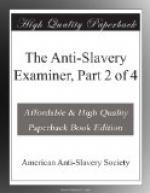[Footnote A: We are here reminded, by the force of contrast, of the noble spirit manifested by the free colored people of our own country. As early as 1817, a numerous body of them in Philadelphia, with the venerable James Forten at their head, pledged themselves to the cause of the slave in the following sublime sentiment, which deserves to be engraver to their glory on the granite of our “everlasting hills”—“Resolved, That we never will separate ourselves voluntarily from the slave population in this country; they are our brethren by the ties of consanguinity, of suffering, and of wrong; and we feel that there is more virtue in suffering privations with them, than enjoying fancied advantages for a season.”
We believe that this resolution embodies the feelings and determinations of the free colored people generally in the free states.]
CHAPTER IV.
BARBADOES AS IT WAS, AND IS.
According to the declaration of one of the special magistrates, “Barbadoes has long been distinguished for its devotion to slavery.” There is probably no portion of the globe where slave-holding, slave driving, and slave labor, have been reduced to a more perfect system.
The records of slavery in Barbadoes are stained with bloody atrocities. The planters uniformly spoke of slavery as a system of cruelties; but they expressed themselves in general terms. From colored gentlemen we learned some particulars, a few of which we give. To most of the following facts the narrators were themselves eye witnesses, and all of them happened in their day and were fresh in their memories.
The slaves were not unfrequently worked in the streets of Bridgetown with chains on their wrists and ankles. Flogging on the estates and in the town, were no less public than frequent, and there was an utter shamelessness often in the manner of its infliction. Even women were stripped naked on the sides of the streets, and their backs lacerated with the whip. It was a common practice, when a slave offended a white man, for the master to send for a public whipper, and order him to take the slave before the door of the person offended, and flog him till the latter was satisfied. White females would order their male slaves to be stripped naked in their presence and flogged, while they would look on to see that their orders were faithfully executed. Mr. Prescod mentioned an instance which he himself witnessed near Bridgetown. He had seen an aged female slave, stripped and whipped by her own son, a child of twelve, at the command of the mistress. As the boy was small, the mother was obliged to get down upon her hands and knees, so that the child could inflict the blows on her naked person with a rod. This was done on the public highway, before the mistress’s door. Mr. T. well remembered when it was lawful for any man to shoot down his slave, under no greater penalty than twenty-five




